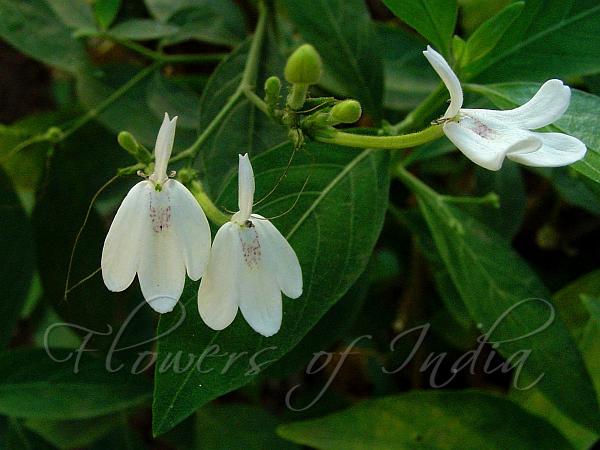|
| Snake Jasmine |
|

|

| File size | 366929 |
| Original date | 12/16/06 8:50 PM |
| Resolution | 1830 x 1218 |
| Flash | Flash did not fire |
| Focal length | 6.3mm |
| Exposure time | 1/250s |
| Aperture | 4.5 |
| Focus Distance | |
| Metering Mode | Spot |
| Camera make | SONY |
| Camera model | DSC-P52 |
| Sensor type |
|
|
|
| Photo: Prashant Awale |
Botanical name: Rhinacanthus nasutus Family: Acanthaceae (Acanthus family)
Synonyms: Rhinacanthus nasuta, Justicia nasuta, Rhinacanthus communis
Synonyms: Rhinacanthus nasuta, Justicia nasuta, Rhinacanthus communis
Native to India, this useful plant is a slender, erect, branched, somewhat
hairy shrub 1-2 m in height. The leaves are oblong, 4-10 cm in length, and
narrowed and pointed at both ends. The inflorescence is a spreading, leafy,
hairy panicle with the flowers usually in clusters. The calyx is green,
hairy, and about 5 mm long. The corolla-tube is greenish, slender,
cylindric, and about 2 cm long. The flowers is 2-lipped; the upper lip is
white, erect, oblong or lancelike, 2-toothed at the apex, and about 3 mm in
both length and width; and the lower lip is broadly obovate, 1.1-1.3 cm in
both measurements, 3-lobed, and white, with a few, minute, brownish dots
near the base. The fruit (capsule) is club-shaped and contains 4 seeds.
Medicinal uses: In India the fresh root and leaves, bruised and
mixed with lime juice, are a useful remedy for ringworm and other skin
affections. The seeds also are efficacious in ringworm. The root-bark is a
remedy for dhobie’s itch. In Sind it is said to possess extraordinary
aphrodisiacal powers, the roots boiled in milk being much employed by Hindu
practitioners. The roots are believed n some parts of India to be an
antidote to the bites of poisonous snakes.
In India the fresh root and leaves, bruised and
mixed with lime juice, are a useful remedy for ringworm and other skin
affections. The seeds also are efficacious in ringworm. The root-bark is a
remedy for dhobie’s itch. In Sind it is said to possess extraordinary
aphrodisiacal powers, the roots boiled in milk being much employed by Hindu
practitioners. The roots are believed n some parts of India to be an
antidote to the bites of poisonous snakes.
Medicinal uses:
 In India the fresh root and leaves, bruised and
mixed with lime juice, are a useful remedy for ringworm and other skin
affections. The seeds also are efficacious in ringworm. The root-bark is a
remedy for dhobie’s itch. In Sind it is said to possess extraordinary
aphrodisiacal powers, the roots boiled in milk being much employed by Hindu
practitioners. The roots are believed n some parts of India to be an
antidote to the bites of poisonous snakes.
In India the fresh root and leaves, bruised and
mixed with lime juice, are a useful remedy for ringworm and other skin
affections. The seeds also are efficacious in ringworm. The root-bark is a
remedy for dhobie’s itch. In Sind it is said to possess extraordinary
aphrodisiacal powers, the roots boiled in milk being much employed by Hindu
practitioners. The roots are believed n some parts of India to be an
antidote to the bites of poisonous snakes. | Identification credit: Prashant Awale | Photographed in Chembur, Mumbai. |
• Is this flower misidentified? If yes,